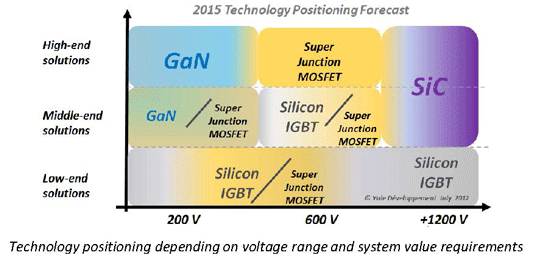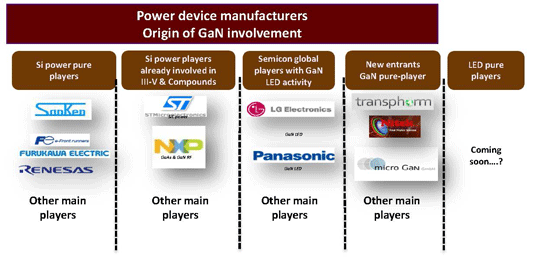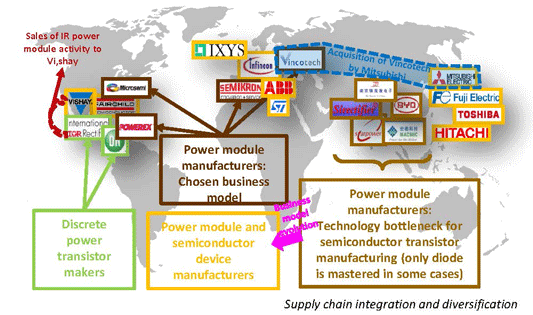- News
20 July 2012
Power electronics device market to reach $20bn this year
The total market for semiconductor devices (discretes, modules and ICs) dedicated to the power electronics industry will reach $20bn in 2012, according to the report ‘Status of the Power Electronics Industry’ from market research firm Yole Développement. With applications as diversified as hybrid cars, photovoltaic (PV) inverters, lighting, and energy – and with a voltage ranging widely from a few volts to a few thousands volts – power electronics will remain one of the most attractive branches of the semiconductor industry for the next decade, the firm expects.
The power electronics industry is now addressing applications involving conversion and motion, and requires lighter/smaller, cheaper and more efficient systems, notes Yole. This evolution starts with improvements at the semiconductor level, and there are four technologies that are the best candidates for handling these new system requirements: silicon IGBTs (insulated-gate bipolar transistors), super-junction (SJ) MOSFETs, gallium nitride (GaN)- and silicon carbide (SiC)-based devices.
Already well established in the market, IGBTs account for $1.6bn in the medium- to high-voltage range. However, Yole says that there is a trend to decrease the voltage range in order to access more segments by targeting consumer applications such as TVs, computer adapters and cameras. At the same time, SJ MOSFETs present in these applications offer faster switching frequencies and competitive cost. Yole forecasts that the SJ MOSFET market will reach $567m by the end of 2012.
GaN and SiC also look promising to surpass silicon’s performance and enhance inverter capabilities, notes Yole. However, these materials are still expensive and the technology is not yet ready, the firm reckons. On the other hand, both of these materials can benefit from their developed status in the LED industry, and plenty of LED players have been paying attention to the opportunity that power electronics represent, it adds.
Each technology faces development issues
In the report, Yole identifies the needs for using the four main technologies. Nevertheless, all still have issues in offering ideal solutions for each application in every power/voltage range. There are two consequences:
- GaN and SiC are not yet mature enough for the power electronics market: GaN needs technical enhancements in the manufacturing process, especially for epitaxy thickness, and SiC is an expensive material that precludes implementation in consumer sectors.
- Segmentation between technology and power/voltage range will take place, so some segments will adopt only one ‘best’ technology, reckons Yole.

Each technology has a particular industry structure
While SJ MOSFETs are seeing new players and foundry service suppliers, the IGBT chip industry is becoming consolidated by the presence of large players – such as Infineon, Mitsubishi Electric and Fuji – involved in many application sectors. However, the IGBT (and SJ MOSFET) modules business is growing and new players are entering the sector to provide solutions for cooling, interconnections, substrates, packaging, and gel.

Graphic: Interaction between power GaN industry and other related industries leading semiconductor players to enter power GaN business.
On the other hand, the SiC industry, which has been led so far by Cree Inc, is now an interesting playground for new players, says Yole. With access to lower-cost material, the SiC industry now has the possibility of ramping up in volume and becoming more established. However, apart from the PFC (power factor correction) business, the capabilities of SiC technology show that it will almost certainly be dedicated to high-power/high-voltage applications. Last but not least, SiC companies have arisen in China, which will present competition and tougher access to local markets.
At the moment, the GaN industry is mostly US-based, says Yole. International Rectifier, EPC, Transphorm, Microsemi and GaN Systems have now presented fully off-the-shelf or customized products. However, some pioneers such as MicroGaN, NEC and Powdec are showing that there is a trend towards globalization in the GaN manufacturing industry. At the same time, the market is still soft, and LED players are considering using their technology base to enter the power electronics market, which will be very much low-power/voltage-oriented, notes Yole.
The power electronics industry has great potential for growth, reckons the firm, driven mostly by energy-related applications (production, distribution, consumption), which presents an open and accessible market, even for small players.
Technology & cost requirements, driven by inverter industry
Because it comprises just part of the power electronics industry, the power semiconductor industry must meet the demands of a bigger system: the inverter. For example, some expensive solutions have still not been implemented, even if the device and module performances are much higher than the existing output.

The report therefore provides an analysis of the inverter market and the players, as well as the industry evolution, in order to illustrate the role of power semiconductors and to analyze which drivers will be key for various applications.
In addition, the report underlines the expected technical developments of an inverter – depending on the applications – and how power semiconductors can contribute to these improvements. Indeed, power devices ameliorations will be useful only if they fit with passive and connective devices, as defined by the needs of the inverter, Yole notes.
Geographical positioning is also critical in the power electronics area, especially with the boom in China and other emerging countries, but also because several applications (PV, wind, electric vehicles) are supported by local governments, comments the market research firm. Yole therefore also provides a geographical and supply chain analysis for the power electronics industry, from semiconductors and passive devices to the inverter stage.
GaN power semi market to grow at 64% to $1.75bn by 2022
GaN power semiconductor market to exceed $1bn by 2021
GaN power electronics market may top $1bn in a few years
GaN gaining traction in commercial applications
